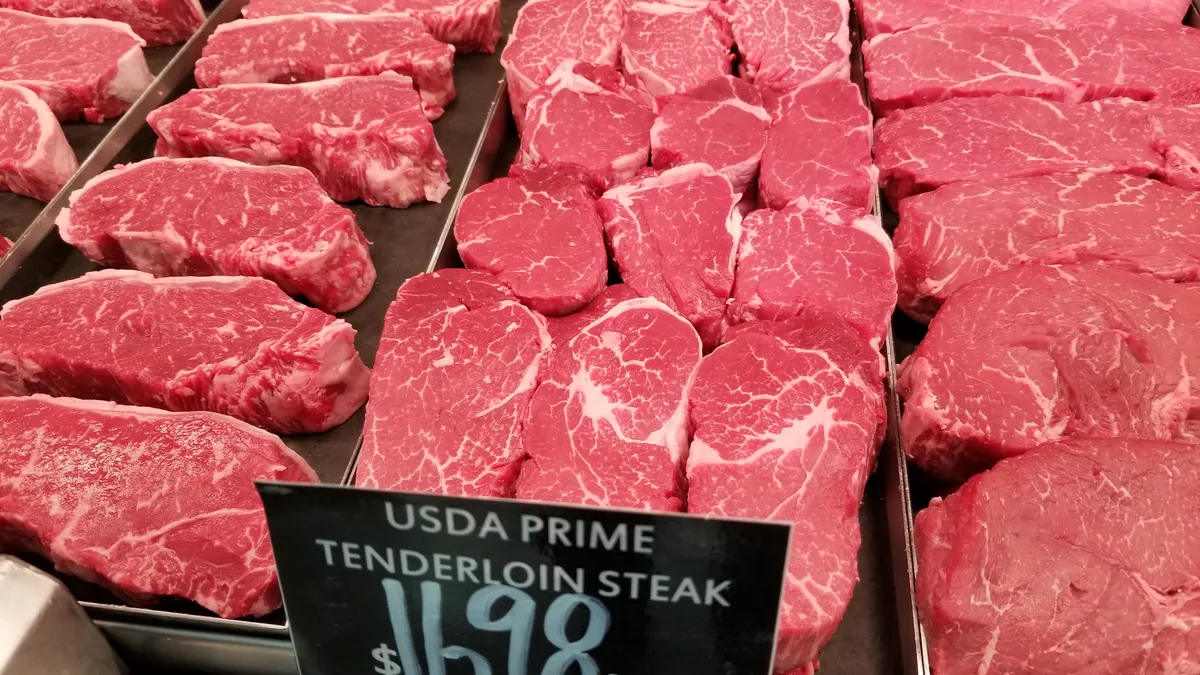Dive Brief:
- After a successful pilot program in 200 of its store locations during 2018, Sam's Club told Grocery Dive in an email that it now offers USDA prime beef at all retail locations, including a variety of popular cuts like tenderloin, ribeye, striploin, sirloin and whole briskets.
- Prime is the highest designation that the USDA Agricultural Marketing Service assigns to red meat. Trained graders evaluate cuts of meat and categorize them as prime, choice or select based on an official grading standard that assesses tenderness, juiciness and flavor. Cuts that grade prime have the highest levels of marbling.
- Not all grocers carry USDA prime, and if they do the selection is usually limited. Albertsons, Walmart, H-E-B, Kroger, Whole Foods and Costco are a few of the national retailers that stock prime beef, as well as many custom butcher shops.
Dive Insight:
Stocking USDA prime is a risky, but strategic move for Sam's Club, considering the costs that a retailer faces if there aren't enough shoppers wanting top dollar steaks. While fresh meat products that don't sell before they spoil could be incorporated into ready-to-eat meals, this is a far less cost-effective solution for pricey prime beef. The company's decision, however, to stock prime cuts at all of its store locations suggests that consumers were very receptive to the trial run and that the chain was able to move the cuts before the expiration date hit.
Fresh beef has always been a staple of any supermarket meat department, but it's also one of the priciest items on shoppers' lists—especially prime cuts. As e-commerce continues to grow in popularity, retailers can count on fresh meat to keep some folks coming to the store to do their shopping due to leeriness over ordering fresh meat products online.
In fact, fresh categories are driving nearly half of sales for brick-and-mortar stores, generating over $177 billion in sales during 2017 according to Nielsen. Fresh meat is growing at a rate of 1.5% of per year. Although some folks think alternative protein is hot on meat's heels, sales of alternative protein products are only estimated to reach $5.2 billion by 2020 according to a report from investor initiative FAIRR.
On top of consumers' distrustfulness of mail-order beef, Sam’s Club is likely banking on the steady nationwide climb in red meat and poultry consumption with the USDA estimating an average of 222.2 pounds per person in 2018, up roughly six pounds from 216.9 pounds in 2017. This equates to about 10 ounces per day, which may explain why shoppers want a reliable supply of fresh meat that can be cooked up quickly.
Still, price per pound is the most important factor that consumers consider when shopping for meat according to the 2018 edition of the Power of Meat report, even over appearance. On average, prime is about five times more expensive than Choice. And when survey participants were asked to grade themselves on their knowledge and understanding of the USDA beef grading system, only 30% reported feeling very knowledgeable while 48% felt they only understood the basics. Add in the fact that grocery prices are on a continued five-year climb and Sam's Club's decision to stock prime beef nationwide seems even bolder.
Sam's Club has also recently made an effort to increase its local food offerings, which likely includes a considerable amount of fresh products. In 2018, it extended its same-day delivery partnership with Instacart to around 350 of its 600 stores, which might create a solid compromise for shoppers who like the convenience of online shopping but who are skeptical of getting meat via mail. Prior to that, it made its premium membership package more enticing by adding no-minimum free shipping on 95% of items, which includes a handful of meat products.












